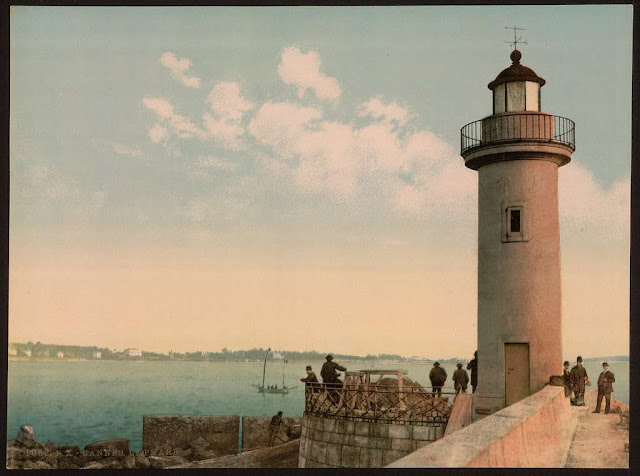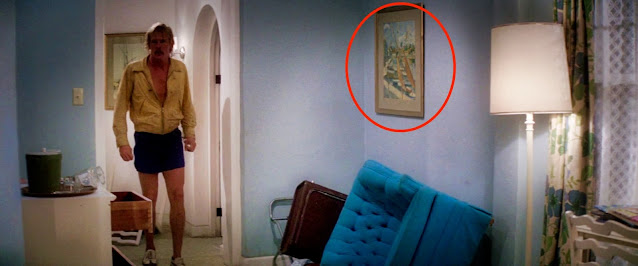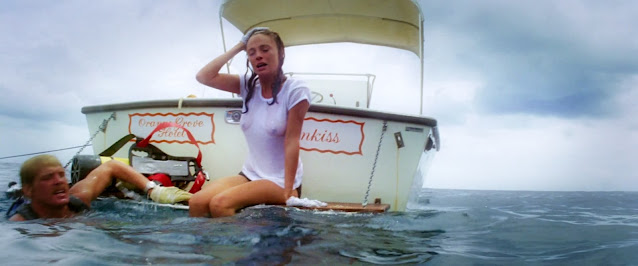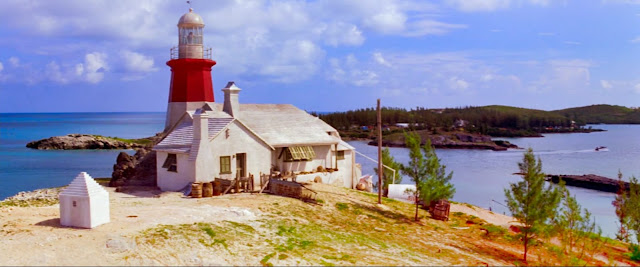THE DEEP and Impressionism hiding in 'plein air'
 |
| Jacqueline Bisset next to an almost forgotten painting by French Impressionist Pierre Bonnard (Source Sony Pictures). |
When The Deep Production Designer Tony Masters, finished David (Nick Nolte) and Gail's (Jacqueline Bisset) Orange Grove Hotel interior, the set revealed Bermuda's coastal palette and paintings by artists known for their use of intense colour, light, and Impressionism in "plein air".
 |
| Bermuda "vast turquoise", "lush greenery", "almost unnaturally colorful beauty" (Source Sony Pictures). |
Producer Peter Guber wanted The Deep to be portrayed in "jewel-like color" and when the production arrived in Bermuda, in August 1976, saturated colour was everywhere. Bermuda was a "lovely island ... in the full flush of summer", "gorgeous pink", "vast turquoise", "rainbow-colored", "lush greenery", "peaceful ... bobbing boats" "twinkling across the water", and "almost unnaturally colorful beauty". "It's hard to find locations that look real here—this whole place looks like one giant movie set!", said Masters (Guber & Witus, 1977).
 |
| Legendary production designer Tony Masters (Source IMDB) |
Masters began sketching different locales and adapting them into the story. The fictitious Orange Grove Hotel combined three real places including the cottage interior set which was built inside a sail loft at Bermuda's Royal Naval Dockyard. The cottage design included multiple rooms and even marked the theatrical orientation of the sea.
 |
| Tony Master's vision of the full Orange Grove bungalow interior set (Source Sony Pictures via National Museum of Bermuda) |
Two cottage rooms feature in Marvel's comic book special adapted from the screenplay by Peter Benchley and Tracy Keenan Wynn. Slake (Dick Anthony Williams) and Ronald (Earl Maynard) attack Gail in the cottage bedroom and bathroom (edited below).
 |
| An early screenplay revealed by the Marvel adaptation shows no voodoo (Credit Marvel). |
However, the Marvel adaptation shows no trace of the "painted bird number", as the voodoo scene was internally called, and which was a key plot point in Benchley's novel (Guber & Witus, 1977). According to Guber, the attack on Gail went through various rewrites until it more closely resembled the voodoo encounter from the novel.
 |
| (Source Sony Pictures) |
 |
| Tony Master's vision of the Orange Grove bedroom (Source Sony Pictures via National Museum of Bermuda) |
The bedroom palette reflected Peter Guber's turquoise impression of Bermuda's seascape. Turquoise is a two tone blue-to-green and complimentary shades were placed throughout the set. These include the bedspread, wall, the mat board in framed pictures, the curtains, and Bisset's towel.
 |
| The complimentary turquoise swatch of wall, bedspread and Bisset's towel (Source Sony Pictures). |
Peter Benchley based the character of Romer Treece (Robert Shaw) on the life of Bermuda explorer Teddy Tucker. Tucker, who worked as a consultant on the film and had a cameo as the Harbor Master at Coffin's dock, was a lifelong watercolourist who recorded many of the shipwrecks he discovered as marine art.
 |
| Teddy Tucker paints in watercolour at home in Bermuda (Source Teddy Tucker Adventure is my Life) |
The Orange Grove bungalow was "perfect down to the last gold-framed watercolor" and Masters chose French impressionists Pierre Bonnard (1867-1947), Henri Manguin (1874-1949), and American Cecile Ryden Johnson (also Cecile Johnson) (c1916-2010). These artists' portfolios include a love of seascape painted in "plein air" and Johnson painted frequently in Bermuda.
Pierre Bonnard
Pierre Bonnard's Port of Cannes 1923 hangs next to the cottage front door.
 |
| "St. David's is the only place you'll be safe tonight". Robert Shaw next to Pierre Bonnard's Port of Cannes 1923 (Source Sony Pictures). |
 |
| "I always think about us" Bonnard's Port of Cannes 1923 to the left of Nick Nolte (Source Sony Pictures). |
The painting captures "peaceful ... bobbing boats" and the old Cannes lighthouse, at the port of Cannes in 1923.
 |
| Pierre Bonnard Port of Cannes 1923 |
The lighthouse of Bonnard's painting was first lit in 1854, moved a short distance in 1930, destroyed during World War II, and rebuilt in 1950. The choice of this specific painting, with its lighthouse destroyed in 1944, hints at the fate for the The Deep's St. David's Lighthouse.
 |
| Photo of the Cannes Lighthouse (Le Phare Cannes), between ca. 1890 and ca. 1900, seen in the centre of Bonnard's composition (Source Library of Congress) |
Port of Cannes 1923 seems absent from the contemporary texts of Bonnard's work which comprise similar compositions of the same harbour including The Port of Cannes 1925 (Terrasse, 1964), and Le Port de Cannes 1935. The 1923 painting in The Deep was registered with the United States Copyright Office in 1967, by the New York Graphic Society, as a colour reproduction of an oil painting. The Society's catalogues credit ownership to a "Private Collection" (below).
 |
| (Source New York Graphic Society 1980) |
It's not unusual for prints of paintings in private collections to be sold under licence and a high quality copy of Port of Cannes 1923 is available from Getty Images.
 |
| Henri Manguin Le 14 juillet à St Tropez, côté gauche (The 14th July at St. Tropez, left side) 1905 (Source Sony Pictures). |
 |
| Henri Manguin Le 14 juillet à St Tropez, côté gauche |
 |
| Jacqueline Bisset passes between Bonnard (left of Bisset) and Manguin (right) (Source Sony Pictures). |
 |
| (France 3 / Culturebox) |
Cecile Ryden Johnson
Cecile Johnson began her 'plein air' career in California in the early 1940s. Her Bermuda commissions included the (then new) Bank of Bermuda on Church Street, the (former) Castle Harbour Hotel, Trimingham Collection, the New York Office of the Bermuda Trade Development Board, and private individuals.
 |
| Renowned 'plein air' watercolourist Cecile Johnson |
In 1961, Teddy Tucker also worked with the Bermuda Trade Development Board promoting Bermuda in New York and giving lectures with the Tucker Treasure.
 |
| "I wouldn't miss it for anything. They've gone and moved Bermuda to 45th Street for a week" (Source New York Times 31 January 1965 References) |
Johnson had many friends in Bermuda and her assignments included the Princess Hotel which commissioned the original watercolours from the prints hanging on David and Gail's cottage wall. The series known as Cecile Johnson Bermuda Prints enclosed a raisonné:
"In these charming scenes Cecile Johnson's brush has captured the subtle delight that is Bermuda. Her effective use of the elusive art of watercolour interprets the soft pastels and white rooftops of Bermuda against the dramatic skies and shining water that envelops the island. Painting with watercolour is like painting with light, and the luminosity of this gem of an island set in a bright sea shines in these paintings."
There are three of Johnson's Bermuda Prints visible on set:
- Market Square - St. George's - Bermuda,
- Tucker's Town Cove - Bermuda, and,
- Mid-Ocean Golf Course - Tucker's Town - Bermuda.
Tucker's Town Cove and Mid-Ocean Golf Course hang above the bed (below).
 |
| Cecile Johnson's Tucker's Town Cove (left) and Mid-Ocean Golf Course (right) (Source Sony Pictures). |
 |
| Cecile Johnson Tucker's Town Cove Bermuda |
 |
| Cecile Johnson Mid-Ocean Golf Course Tucker's Town |
On the opposite wall hangs Market Square - St. George's - Bermuda (below).
 |
| Cecile Johnson Market Square - St. George's - Bermuda |
 |
| Cecile Johnson Market Square - St. George's - Bermuda |
The St. George's location, where King's Square meets the bridge to Ordnance Island, is very recognisable as the site where Johnson painted "with light".
In 1972, the Princess Hotel, which originally commissioned the Johnson watercolours hanging on set, expanded its portfolio with a brand new hotel at Southampton on Bermuda's South Shore. Four years later the Southampton Princess (now the Fairmont Southampton) became the headquarters of The Deep when the production team arrived in Bermuda.
The hotel appears near the Gibb's Hill Lighthouse during the film's opening.
 |
| Gibb's Hill Lighthouse (centre) and the Southampton Princess (circled) in 1976 (Source Sony Pictures) |
Johnson also created a 60 square foot polymer acrylic mural in the Regatta Room of Bermuda Airport's former passenger terminal (Civil Air Terminal). The canvas celebrated the finish of the Newport-Bermuda yacht race by St. David's Lighthouse and showed the yachts in the proper finishing order and sail colours. The boat Thunderhead, which was often sailed by a member of Cecile's family, was shown in 6th place.
Cecile Johnson's work was the perfect choice for Tony Masters because his exacting design philosophy matched the intrinsic authenticity of Johnson's art. She had a lifelong relationship with Bermuda, provided a Bermuda Print commission within the context of hotel accommodation, and was a St. David's Lighthouse seascape artist.
The current whereabouts of Johnson's mural is unknown. Some of the airport's artwork was already in storage before the new Bermuda Skyport passenger terminal opened in December 2020. Some say it may even have been demolished.
Do you know where Cecile Johnson's Newport-Bermuda yacht race Regatta Room mural is? Contact thedeepfilminglocations(at)gmail.com or leave a comment below.



Comments
Post a Comment